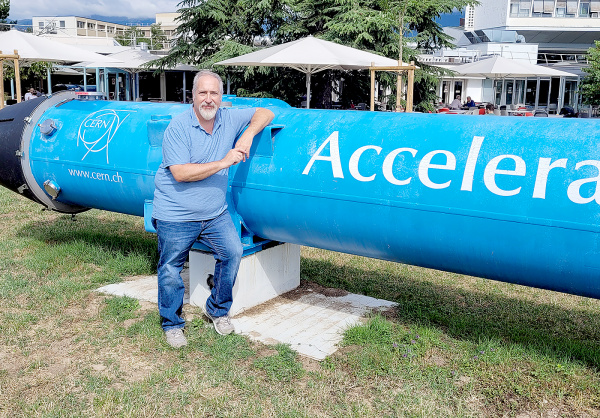The Net that Holds the World

Submitted photo
Lee Sawyer, physics professor and director of Louisiana Tech’s chemistry and physics programs, stands against one of the magnets used for testing the Large Hadron Collider, the particle accelerator that allowed an international collaboration of physicists to prove the existence of the Higgs boson, or the “God particle.”
Throughout the far reaches of the universe, there is an energy field, surrounding and binding matter together.
Everything that has mass gets its mass from this field. Without it, life as we know it could not exist.
No, it’s not George Lucas’s “Force” — it’s the Higgs field, and the accompanying Higgs boson particle.
The official discovery of the Higgs boson, one of the most significant achievements in the history of physics, celebrated its 10th anniversary last week.
Several Louisiana Tech faculty, researchers and students had a hand in making that achievement a reality.
Professor of Physics Lee Sawyer and associate professor Markus Wobisch were among the Tech contingent who contributed to the international collaboration known as CERN that proved the Higgs boson’s existence with its Large Hadron Collider (LHC).
Located in Geneva, the LHC essentially shoots beams of subatomic particles along a 17-mile circuit and smashes them together at nearly lightspeed, creating effects at the particle level that can’t be observed anywhere else on Earth.
That’s how the Higgs boson was proven to exist, some 50 years after it was first theorized.
“Literally, this particle has been searched for my entire life,” said Sawyer, who was born in 1963, a year before the Higgs was first publicly proposed.
Fundamental particles like electrons and quarks are given their mass through their interactions with the Higgs field. The Higgs particles that produce the field are sometimes called the “God particle.”
Proving the Higgs was the missing cornerstone of the “Standard Model” — the scientific framework explaining the building blocks and forces of nature.
Wobisch described the Standard Model, and the Higgs’ place within it, like a net.
“We observe that the net is stable — meaning the theory was consistent and it described our observations — but we were not able to see what kept the net together,” Wobisch said.
The Higgs boson was proposed to be the “knot” holding the net of the Standard Model together.
“If one would be able to find this knot, this would make the picture of the net, and the explanation of its stability, complete,” Wobisch said.
Finding the “knot” took more than 30 years of construction and planning and tens of thousands of research hours.
Sawyer, Wobisch and Louisiana Tech students worked, and are still working, with the ATLAS collaboration, one of the LHC’s two detector facilities. The ATLAS alone comprises some 5,500 members of the particle physics community.
The Tech group’s primary responsibility is helping to ensure data quality — certifying that the mountains of data that come out of the LHC are usable for physics analysis.
“There are over 100 million channels of electronics in the ATLAS detector, and we get collisions every 24 nanoseconds,” Sawyer said. “Data Quality is a critical component to being able to do physics with an experiment this large and complicated.”
At the time of the Higgs boson announcement in 2012, the Tech team included Sawyer, Wobisch, the now-retired Z.D. Greenwood, post-doctoral researchers Matthew Tamsett and Catrin Bernius, graduate students Ram Dhullipudi, Arirvan Sircar, Rajiv Subramaniam, Alex Johnson, Khadeejah Alghadeer and David Palma, and undergraduate student Andrew Touchet.
Before that, the Tech group was involved with a previous particle collider in Illinois.
“It was there that we saw first hints of the Higgs boson, but these hints were much too weak to claim a discovery,” Wobisch said.
Patience and tireless effort eventually won out.
As he is today, Sawyer was at CERN in June 2012 when the Higgs discovery was finalized.
“I was here when we had our internal ATLAS meeting, in which our Higgs search results were very carefully reviewed by the collaboration and the decision was made to inform the CERN director-general that ATLAS had a signal (of the Higgs),” he said.
CERN called a seminar on July 4, 2012 to announce the discovery to the world, by which time Sawyer was back in Ruston.
“I opened up one of the smart classrooms in Carson-Taylor Hall at 2 a.m.,” he remembers. “We had more than 30 people show up. Not just physics folks, but students and faculty in other programs and just people in the area. I think one family drove over from Bossier City.
“We all watched, and everyone burst into applause when (the ATLAS spokesperson) showed the final conclusive plot.”
Physicists say the importance of the Higgs boson cannot be overstated, as it changed the trajectory of not only particle physics but of humans’ understanding of the world around them.
And there’s ever more to be learned.
“While the Standard Model is the most precise and most thoroughly tested theory in human history, there are some pieces of the universe that it does not include,” Sawyer said. “We know that there is some sort of ‘Dark Matter’ forming halos around galaxies and affecting their rate of rotation. The Standard Model does not predict this. There are some very interesting lines of study, and understanding the Higgs is one of the keys.”
The LHC, the so-called “atom smasher,” was just powered on Tuesday after a three-year maintenance hiatus, marking the beginning of Run 3 — a new four-year period of observation and analysis in which Sawyer, Wobisch and the Tech physics group are very much involved.
Part 2 of this series will delve into Run 3 and more of what’s happening now, 10 years after that groundbreaking discovery in which Tech will always be able to claim a part.

